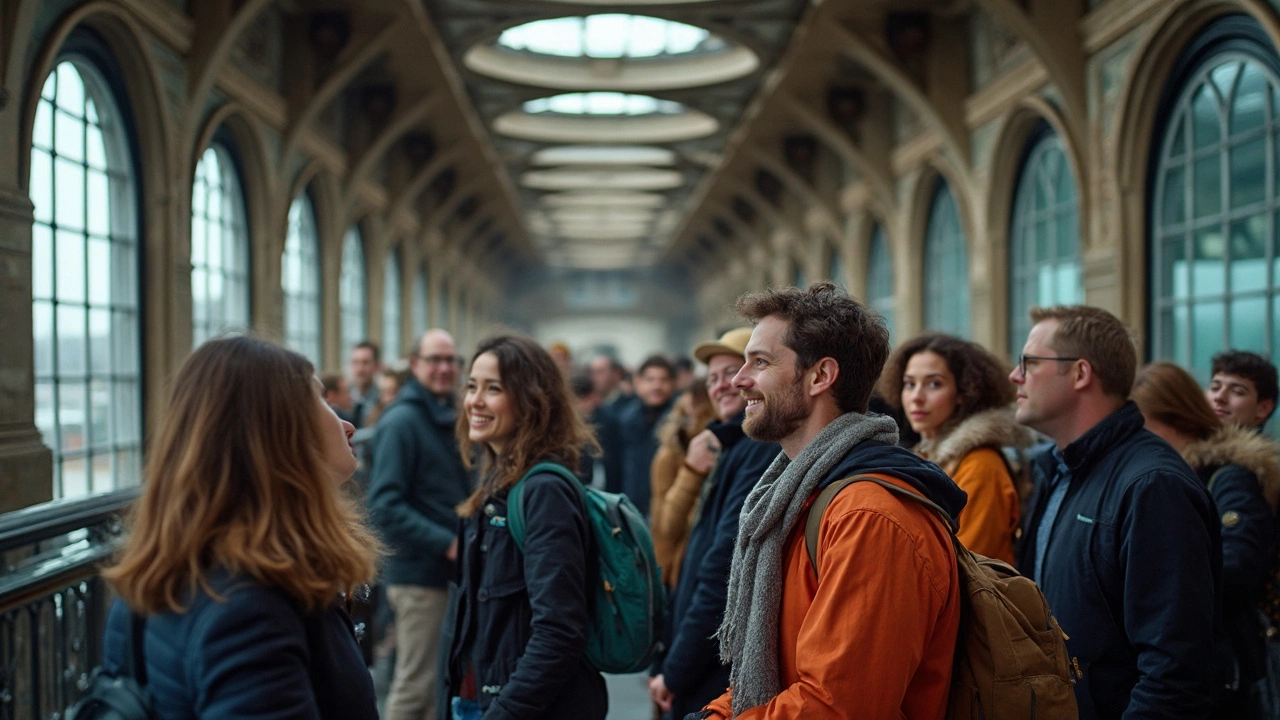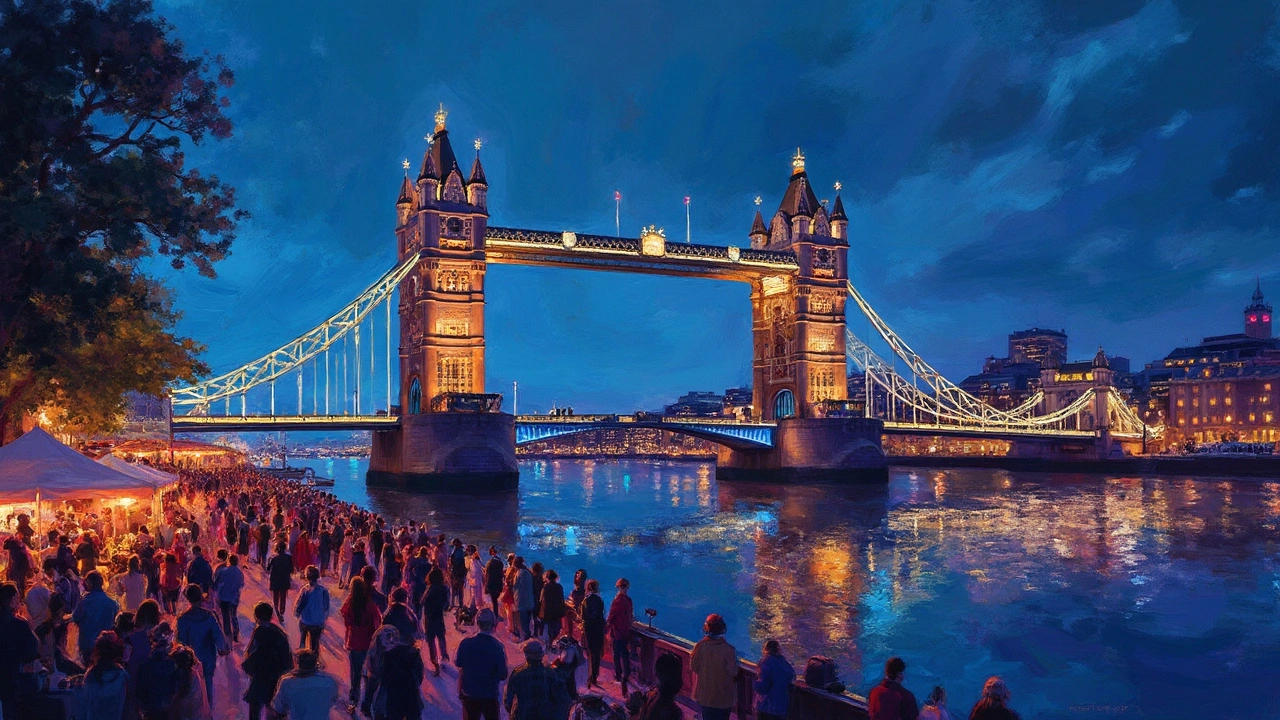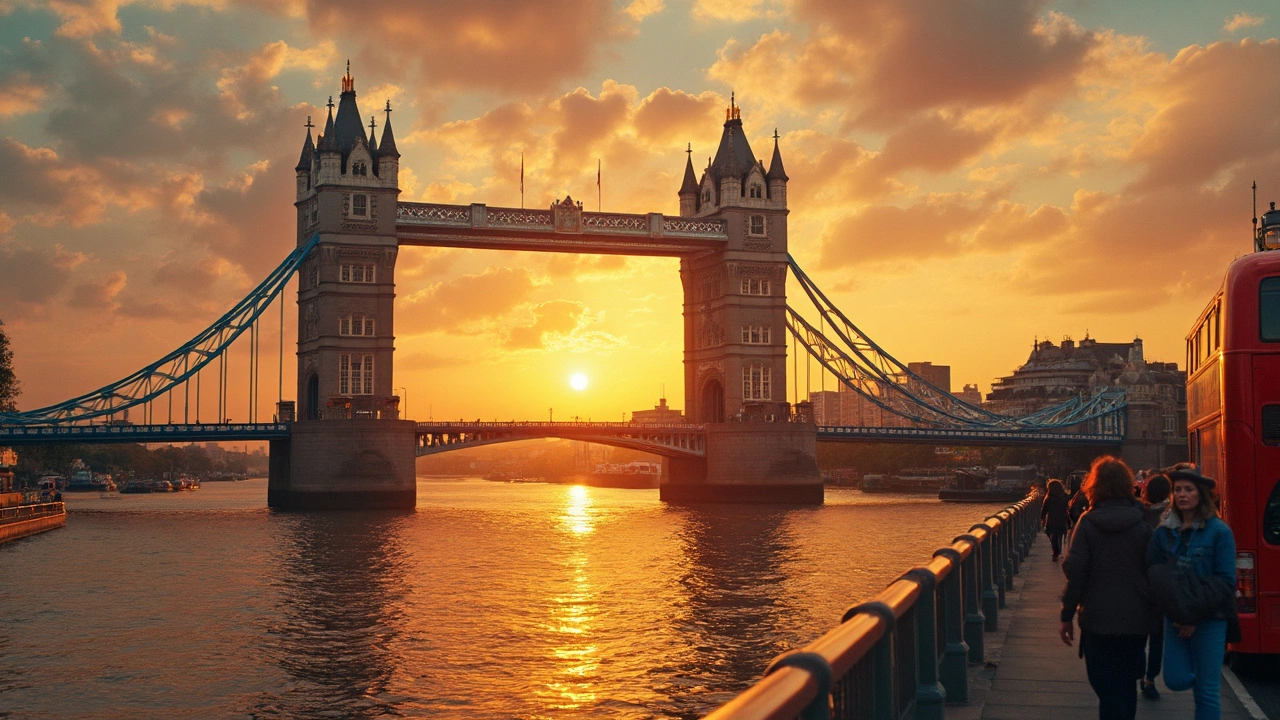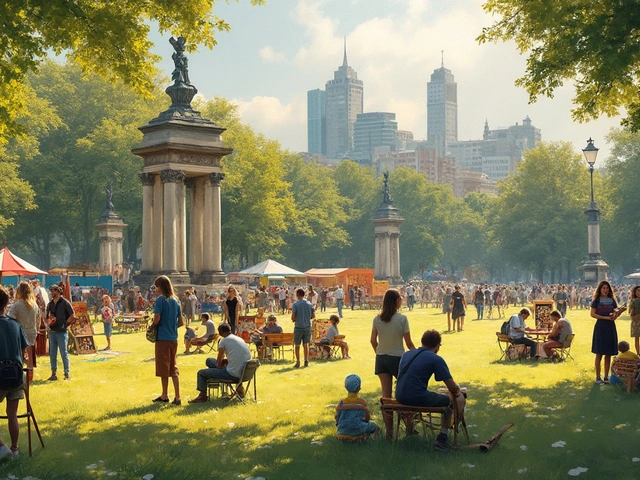Nothing screams 'London' quite like a stroll across Tower Bridge. Whether you're racing to catch a Thames Clipper, snapping selfies in front of its blue-and-white towers, or just heading to work via the South Bank, the Bridge is as much a part of London life as a rainy forecast or a queue for Greggs.
Tower Bridge isn't just another London attraction that tourists tick off—locals cross it daily, and for East Enders, it's almost a familiar friend. If you’re living or working nearby, you’ll know the routine: the warning bells for a bridge lift, the traffic jams on Tower Bridge Road, the hum of city life carried over endless Instagram shots. But there’s a lot more going on here than meets the eye.
Even if you’ve crossed it a hundred times, there are hidden stories and clever tricks to make your next walk over Tower Bridge way more memorable. Think best times to catch the epic bridge lifts, underrated pubs yards away from the north end, cycle tips for dodging tourist crowds, and special late-night events locals swear by. Trust me, you’ll see your neighbourhood landmark in a whole new way.
- History and Construction
- Modern Uses and Unique Facts
- Visiting Tips and Hidden Experiences
- Local Life Around Tower Bridge
- Events and Community at the Bridge
History and Construction
Back in the late 1800s, traffic over the River Thames was out of control. London’s East End was booming, and people needed a way to cross the river without blocking ships sailing up towards the Pool of London. That’s where Tower Bridge comes in—a smart fix built to let both boats and people get where they needed to go.
The project kicked off in 1886 after years of debate about the right design. There was a big worry about making something practical but not ugly, especially with the Tower of London basically next door. To keep everyone happy, they went with a bascule (that’s the fancy word for ‘seesaw’) drawbridge with two towers on each side, connected up high by walkways. The idea? Let big ships through but keep foot and road traffic flowing by raising and lowering the bridge in sections.
Here's some bite-sized history facts you might not know:
- Tower Bridge took eight years to finish (1886–1894).
- It used more than 11,000 tons of steel in its skeleton.
- The Victorian stone cladding was added to fit in with the nearby Tower of London—blending old style with new tech of the age.
- Over 400 workers helped build the bridge, including a handful of brickies and stonemasons who worked through some brutal winters.
The bridge opens by splitting in the middle and lifting its two sides—those "bascules" (which means "see-saws" in French). Originally, steam engines powered the lifts. Today, it’s all run by electricity and a bit of oil.
If you’re keen on numbers, here’s a quick glance:
| Construction Start | Opened | Span Length | Total Length |
|---|---|---|---|
| 1886 | June 1894 | 61 metres | 244 metres |
Locals sometimes confuse Tower Bridge with London Bridge (that’s the plain, modern one upstream). Tower Bridge is the one everyone actually wants to see in person or post on social media—it's the icon you're thinking of. Understanding its history helps you see it for what it is: not just a handy crossing, but a game-changer that let London grow eastwards without breaking up the river’s shipping lanes or cramping the city’s character.
Modern Uses and Unique Facts
When you think about Tower Bridge, you might picture a classic London backdrop for films and tourist snaps. But this landmark isn’t just for sightseeing—it's a fully working bascule bridge, meaning it still opens up for ships several times a week. Hundreds of road vehicles and thousands of people cross the Bridge every single day. The River Thames might be slowing down compared to Victorian times, but you’ll still hear the familiar warning bells as the bridge lifts for tall boats. Check the Bridge’s official website for the lift schedule—it's spot-on and updated daily.
Londoners have watched Tower Bridge get a modern makeover in the last couple of decades, even getting glass-floor walkways in 2014. These walkways aren’t just for Instagram: try walking across during a bridge lift. You’ll feel like you’re floating above the hustle and boats below. If you’re after a quirky office view, Tower Bridge’s Victorian engine rooms and high-level walkways are now open for events, from corporate hires to wedding photos.
It might surprise you, but during big London events (like the London Marathon or Lord Mayor’s Show), Tower Bridge gets shut to car traffic, which gives cyclists and runners a rare chance to own the bridge. That’s a big deal for the city’s cycling crowd—check the TFL updates for closure details.
Let’s not forget the random facts people love to pass around in London pubs:
- The bascules (those opening arms) weigh about 1,100 tons each but can open fully in just five minutes.
- It’s not as old as many people think. Finished in 1894, Tower Bridge is younger than Big Ben, but older than Buckingham Palace as a royal residence.
- More than 40,000 people use the bridge daily—by foot, car, bike, and bus.
- It’s one of the few bridges where you might spot a classic London red bus driving by as the bridge lifts (yep, there’s even a famous story of a Number 78 bus once jumping across the split bascules in 1952).
You’ll hear locals arguing over this pub quiz classic: Is Tower Bridge the same as London Bridge? Not even close. Tower Bridge is the showpiece. London Bridge is a plainer structure a bit upstream—don’t get the two confused when ordering an Uber!
"Tower Bridge is much more than a photo stop; it’s a living piece of city infrastructure with one foot in history and another in daily London life." – The Londonist
For fun, here’s a quick look at the bridge’s modern numbers:
| Fact | Figure |
|---|---|
| Bridge Lifts per Year | 800-1000+ |
| Pedestrian Crossings Daily | ~24,000 |
| Vehicle Crossings Daily | ~21,000 |
| Glass Floor Height Above Thames | 42 metres |
So the next time someone says Tower Bridge is just for tourists, remind them it’s actually one of London’s hardest working landmarks—right alongside the city’s black cabs and the rumble of the Jubilee Line.

Visiting Tips and Hidden Experiences
So, planning a visit to Tower Bridge in London? Don’t just rock up at any time and expect to beat the crowds. For locals, a walk on the raised glass walkways or snapping photos with the Shard in the background is almost a rite of passage, but there’s a smart way to get the most out of your trip.
If you want those epic city views without waiting for a gap in the foot traffic, hit the bridge early – before 10am, or around sunset, after most group tours have moved on. Early birds get emptier photos and sometimes, especially in winter, a slice of sunrise. Avoid weekends if possible. Weekdays are quieter, particularly outside half-term and holidays.
For something special, check the Tower Bridge website for scheduled bridge lifts. It still opens for ships several hundred times a year, and there’s a full calendar online. There’s nothing like watching the road split and rise right under your feet. If you’ve got friends visiting, they’ll remember it for ages.
- Walk the high-level glass floors: They’re usually less crowded in the mornings, and offer a wild view straight down to red buses and black cabs below. Not for the faint-hearted, but perfect for impressing mates or scaring your parents.
- Hit the engine rooms: Entry comes with your exhibition ticket. You’ll see the original Victorian steam engines and get why old Londoners were so proud of this place. Kids love the huge wheels and machinery.
- Fancy Tower Bridge at night? Grab a ticket to their occasional music gigs or ‘After Hours’ evenings. You get incredible city views with way fewer people – and the city lights from the walkway are next-level.
- Pick a riverside café: Right by the north tower, you’ll find a string of spots for coffee or quick lunches. Locals swear by Pret or Coppa Club for decent food and a chill vibe, plus you can watch the hustle without joining it.
- Walk or cycle over: If you’re cycling, stick to the roads up to the bridge – the cycle lane stops right at the entrance, so you’ll need to merge with traffic (take extra care during peak hours).
Fun fact: Over 40,000 people cross Tower Bridge each day. If you want a quieter visit, try late evenings after rush hour, when the skyline glows and the crowds disappear.
| Bridge Lift Average Frequency | Best Viewing Spots |
|---|---|
| ~800 times/year | Outside City Hall, St Katharine Docks |
Save on tickets if you’re a London local – check Southwark or Tower Hamlets resident deals, or pick up a National Art Pass. Book your entry online to skip ticket queues. If you want to combine visits, the Tower of London is right next door and a combo ticket will save a few quid.
Tower Bridge isn’t just for tourists, and with a few smart moves, you get the best of it without the faff. Just remember to watch for those bridge lifts before planning your commute – nothing will make you late for a meeting like waiting for a tall ship to pass under London’s most iconic crossing.
Local Life Around Tower Bridge
Living or working near Tower Bridge means you’re right in the thick of classic London vibes, but it’s not just about the postcard views. Everyday life here feels surprisingly normal if you’re a regular: there’s the steady foot traffic of office workers, school kids cutting through on bikes, and residents who’ve made Bermondsey or Wapping their stomping grounds for years.
The bridge area smack between the City and Southwark means you get a blend of tourists and locals. Every morning you’ll spot dozens of commuters popping out of London Bridge or Tower Hill stations. There’s usually a burst of MAMILs—middle-aged men in Lycra—whizzing over before 8am to beat the rush hour, especially since TfL’s Superhighway 3 runs close by. For anyone cycling, the new segregated lanes take away a big chunk of the stress, making Tower Bridge a surprisingly good crossing point if you work in the city.
Grab a flat white from local favourite WatchHouse (just five minutes’ walk west of the North Tower) and you’ll see bankers and creatives alike catching a coffee on the river. Foodies swear by Borough Market—barely a 15-minute walk—while honest East End pubs like The Draft House or The Ship keep things real with classic ales and Sunday roasts.
“Tower Bridge is where London knits together the old and the new. It’s part landmark, part local shortcut, and always bustling—whatever the weather,” says Lorna Hughes, London heritage guide.
Residents know how to dodge the crowds, especially during big bridge lifts (about 30 times each month, with timings online). Early mornings or late evenings, you basically have the bridge to yourself—perfect if you’re heading home from a night shift or want stunning sunrise snaps for Instagram. Street performers and market stalls pop up regularly, especially on the south end near Potters Fields Park. It’s not unusual to see artists selling prints, food trucks in action, or community events spilling into the park all summer.
If you’re curious about what life actually looks like here, check out this quick look:
| Who Hangs Out? | Most Popular Times | Best Nearby Spot |
|---|---|---|
| Commuters | Weekday mornings | WatchHouse, Tower Bridge Rd |
| Family walkers | Weekend afternoons | Potters Fields Park |
| Tourists & selfie-takers | Late mornings, all summer | On the bridge walkways |
It’s not glamorous, but being a local near Tower Bridge means you’re at the very crossroads of London life: old warehouses-turned-flats on one side, sightseers snapping photos on the other. When football’s on at the nearby Bermondsey pubs or the summer music festivals set up near City Hall, it all mixes together. If you want to feel plugged into true London, this bridge is a daily backdrop that never gets old.

Events and Community at the Bridge
Here’s the thing—Tower Bridge isn’t just a relic for postcard photos. For folks living in London, it’s a buzzing hub for community events that are actually worth the trek. Right by the north side of the bridge, the public space gets used for everything from outdoor art displays to charity runs that shut down half the area for thousands of runners. If you want to catch something big, the London Marathon always runs right over Tower Bridge and you’ll feel the city’s energy on race day with crowds, banners, and the sound of cheering practically echoing off the stone.
Every summer, Potters Fields Park throws on food festivals, world street food markets, and family picnics right next to the bridge. You’ll smell the barbecue before you even see the stands. Don’t forget the illuminated winter walks during Christmas—local businesses team up to light the bridge and host pop-up markets along the Thames walkway. It feels like proper London at its best.
For parents and schools nearby, Tower Bridge sometimes runs after-hours educational tours, letting small groups walk the famous glass walkway in the evening when the city is all lit up—most Londoners don’t even know these are open to locals by booking ahead. If you’re into photography, keep an eye out for local meet-ups; some groups (like Instagrammers London) host sunrise sessions here, because the light bouncing off the Thames is unreal.
- Catch a Tower Bridge lift—it’s scheduled almost daily, and the times are posted online so you can time your visit. Nothing says ‘London insider’ like knowing when the big boats go through.
- The lower plaza frequently hosts sports screenings in summer—think big screens for Wimbledon or even World Cup footie games with Tower Bridge in the background. Arrive early; it gets packed with locals fast.
- Local charities (look out for Southwark Foodbank and The Felix Project) run sponsored walks across multiple bridges, and Tower Bridge is always the highlight, especially for community fundraising days.
| Event | Typical Timing | Local Tip |
|---|---|---|
| London Marathon Crossing | April | Arrive before 10am for a front-row view |
| Christmas Lights & Markets | November-December | Best after 5pm for the full lights |
| Summer Food Markets | June-August | Bring cash—queues get long for card payments |
One last thing—if you’re after something a bit more low-key, locals often just grab a coffee from a nearby Costa or a pint at The Anchor Tap and sit by the river watching the sunset behind Tower Bridge. Sometimes, the best community vibe isn’t an event at all—it’s just Londoners making the place their own.





